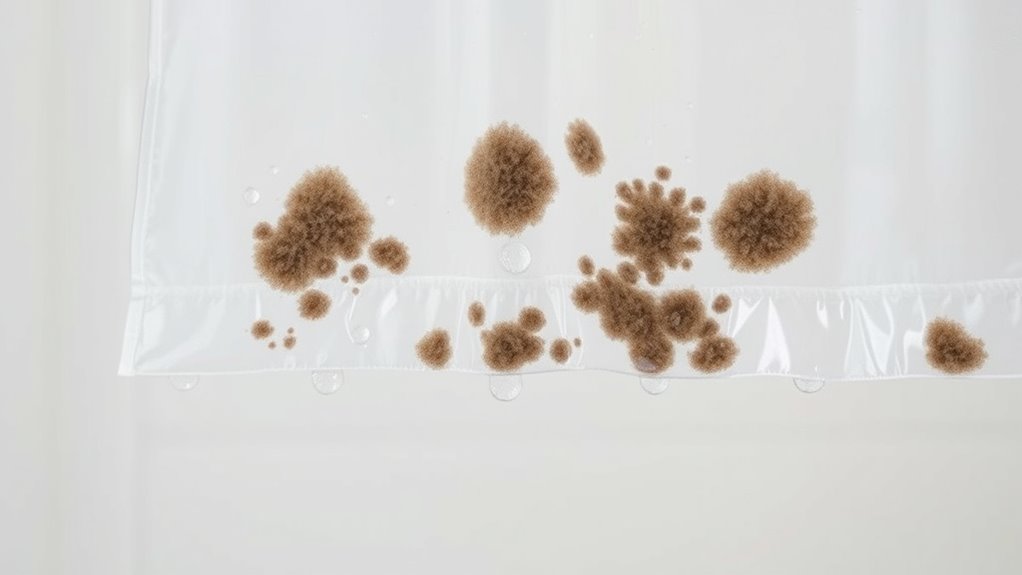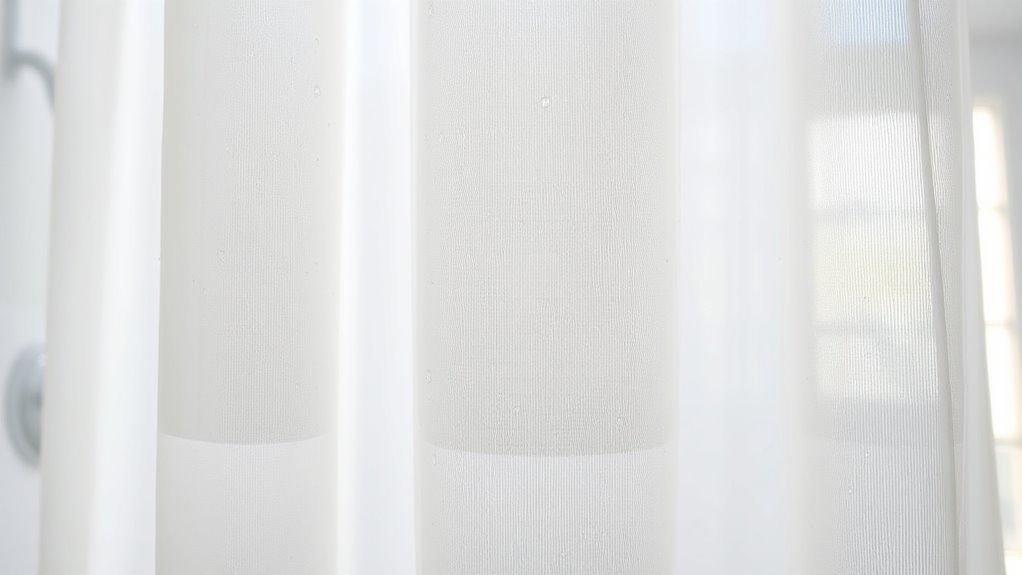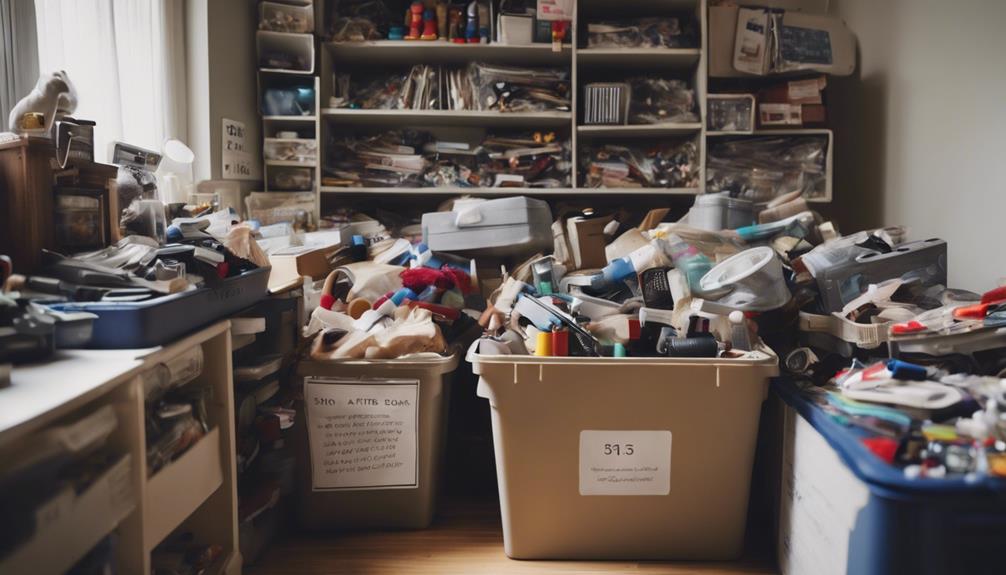Your shower curtain can hide mold beneath its surface because damp, warm environments promote mold growth. Poor ventilation and lingering moisture from showers create perfect conditions for spores to settle and develop. Regular cleaning with vinegar or mold cleaner, coupled with proper drying and ventilation, can stop mold from spreading. If you want to find out more about spotting, cleaning, and preventing hidden mold, keep exploring these essential tips to maintain a healthier bathroom.
Key Takeaways
- Mold often grows in damp, warm environments, making shower curtains susceptible to hidden mold growth.
- Poor bathroom ventilation and excess moisture encourage mold spores to settle and thrive on the curtain surface.
- Visible mold patches indicate the need for thorough cleaning with vinegar, baking soda, or commercial mold cleaners.
- Regularly dry the curtain completely and consider mold-resistant options to prevent future mold buildup.
- Improving ventilation, using dehumidifiers, and proper maintenance are essential steps to fix and prevent hidden mold.

Have you ever noticed black or greenish spots forming on your shower curtain? If so, you’re not alone. These unsightly patches are often signs of mold growth, which can thrive in the damp, warm environment of your bathroom. But before you panic, know that addressing this issue is straightforward if you understand what’s causing it and how to fix it. One common culprit is poor ventilation. When your bathroom lacks proper airflow, moisture lingers longer, creating an ideal environment for mold to develop. Without good ventilation, the excess humidity settles on your shower curtain, encouraging mold spores to settle and grow. Improving airflow by using an exhaust fan or opening a window during and after your shower can drastically reduce moisture levels. This simple step can prevent mold from taking hold in the first place and keep your bathroom fresher longer. Proper ventilation is essential to maintaining a healthy bathroom environment and preventing mold growth. Additionally, using a humidistat can help monitor and control humidity levels more precisely, further reducing mold risk.
Once you’ve tackled ventilation, it’s vital to focus on cleaning techniques. Regular cleaning is key to preventing mold from establishing itself on your shower curtain. Use a mixture of white vinegar and water or a commercial mold cleaner to scrub the curtain thoroughly. Pay special attention to the areas where spots are forming, as these are the most susceptible to mold growth. Let the cleaning solution sit for a few minutes to break down mold spores before rinsing thoroughly. For fabric shower curtains, you can even toss them in the washing machine with hot water and a cup of baking soda or vinegar. After cleaning, always guarantee your curtain is completely dry before hanging it back up. Mold thrives in damp environments, so keeping your curtain dry is just as important as cleaning it. Using a high-quality, mold-resistant curtain** can provide extra protection against future mold development. Incorporating a dehumidifier in your bathroom can also help reduce overall humidity and discourage mold growth. Regularly inspecting your curtain for early signs of mold can help catch problems before they become widespread. Remember, replacing old or damaged curtains can also be an effective step in preventing mold** buildup.
Frequently Asked Questions
Can Mold in Shower Curtains Cause Health Problems?
Mold in your shower curtain can cause health problems because mold spores may become airborne, leading to allergic reactions or respiratory issues. If you’re sensitive or have asthma, exposure can worsen symptoms. Regularly cleaning or replacing your shower curtain helps reduce mold buildup, preventing spores from spreading and protecting your health. Pay attention to any signs of mold, and take action quickly to keep your bathroom safe and healthy.
Are Plastic or Fabric Curtains More Resistant to Mold?
You might find it surprising, but fabric curtains are generally more prone to mold than plastic ones because their porous material traps moisture. For material comparison, plastic curtains resist mold better due to their non-porous surface. To keep either type mold-free, follow maintenance tips like regular cleaning and proper ventilation. Choosing plastic might save you effort, but staying diligent with cleaning is key to preventing mold growth on any shower curtain.
How Often Should I Replace My Shower Curtain?
You should replace your shower curtain every 6 to 12 months, depending on your cleaning schedule and curtain material. If you notice mold, stains, or persistent odors, it’s time for a new one. Fabric curtains may need more frequent replacement, especially if they’re hard to keep clean, while plastic ones last longer with regular washing. Keeping a consistent cleaning routine helps extend your curtain’s lifespan and prevents mold buildup.
Does Using a Shower Liner Prevent Mold Growth?
Think of a shower liner as a shield against mold villains. Using a shower liner can help prevent mold growth if you practice good shower liner maintenance regularly. It acts as a barrier, reducing direct contact between your shower curtain and moisture. Incorporate mold prevention strategies like regular cleaning and proper ventilation. This simple step keeps mold at bay, making your bathroom safer and cleaner, and extends your shower curtain’s lifespan.
Are There Natural Remedies to Eliminate Shower Curtain Mold?
You can try natural remedies like vinegar or baking soda to eliminate shower curtain mold. Spray a mixture of white vinegar and water on the curtain, then let it sit before scrubbing gently. Baking soda paste can also help remove mold stains. Regularly washing and ensuring proper ventilation are key for mold prevention. These natural solutions are effective, affordable, and safe, helping you keep your shower fresh and mold-free.
Conclusion
So, next time you marvel at your spotless shower curtain, remember it might be secretly plotting mold mischief. Don’t let those tiny spores turn your bathroom into a microbial mansion. Show it some love—wash, dry, and maybe even give it a break from the humidity. After all, a clean curtain not only keeps your bathroom fresh but also saves you from becoming a mold’s unwitting host. Stay vigilant, and keep those spores at bay!
Amina brings over a decade of journalism experience to her role as Editor-in-Chief. Under her leadership, Exquisite Post has flourished, maintaining the highest standards of integrity and excellence. Amina’s commitment to truth and her visionary approach guide the editorial team in producing impactful news stories that resonate with our audience.










